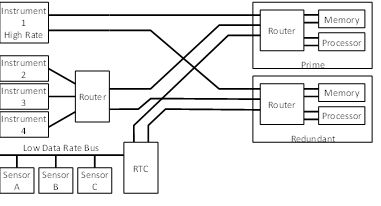Some sensors, like thermocouples, are very low data rate and a low data rate sensor bus (e.g. CAN bus) may be more suitable for gathering data from them. The data gathered may still be sent to the data-handling system via a SpaceWire link if a bridge between the low data rate sensor bus and SpaceWire is used. This is illustrated in Figure 12.
Figure 12 Bridge to Low Data Rate Bus
The Remote Terminal Computer (RTC) provides a bridge between the SpaceWire network and the low data rate sensor bus. The RTC gathers data from the low data rate sensors, puts it in a SpaceWire packet and sends it to the data handling system. Commands for the low data rate sensors (or actuators) can be passed from the data-handling processor to the RTC for distribution to the low data rate sensors.
The advantages of this type of network are:
- Multiple low data rate sensors attached to low speed bus – sensor data packed and sent to data-handling unit over SpaceWire
- Legacy devices can be supported – e.g. Mil-Std 1553
The disadvantages are:
- Two types of bus/network used
The applications for this type of architecture are data handling systems that include several low data rate sensors or that require to support legacy devices.
Other units like the downlink telemetry and uplink telecommand system can be readily included in a SpaceWire system. SpaceWire architectures can be adapted to the mission requirements including links to serve one or more instruments, routers to provide architectural flexibility, and interfaces to electronic ground support equipment.

